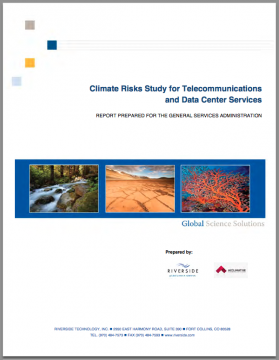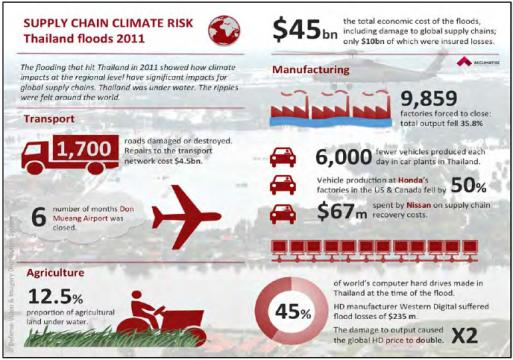Climate Risks Study for Telecommunications & Data Centre Services


An increasing trend towards consolidation and sharing of infrastructure in the US telecommunications sector is increasing vulnerability to climate risks, according to a new report funded by the US General Services Administration (GSA).
The finding comes as part of a wider study into climate risks affecting the world’s largest telecommunications market. Driven in part by recent legislation, the drive towards cost efficiency and expanding overall coverage has led telecoms companies to pool infrastructure resources. This resource sharing reduces ‘redundancy’ in the telecoms sector, increasing sensitivity to climate risks.
‘Redundancy’ is extra capacity in the network which makes the operations less efficient (as there is extra infrastructure assets that are not being used to full capacity), but increases resilience to external shocks like those from climate change (as spare capacity can compensate if some parts of the network fails).
Recent legislation allows companies to share telecommunications and data centre infrastructure and the government has also begun plans to consolidate data centres. At the same time, US federal government bodies have done much work to understand and begin to address climate change risks to essential operations and services.
“We’re seeing the US government expect more from the private sector vendors which provide telecommunications and data centers services. It’s not just about quality and cost of service anymore – it’s also about how resilient those services are to climate change and extreme weather.” Said Peter Adams, one of the lead authors of the report and Climate Risk Consultant at Acclimatise.
The inherent tension between increasing efficiencies of services while maintaining resilience is a challenge that is replicated across all sectors, companies and societies. Successfully walking the tightrope will be crucial to providing stable services that are also cost-effective.
Getting the balance right is particularly important for crucial sectors such as communications. Such sectors not only make large contributions to the economy in their own right, but also allow other businesses and sectors to function smoothly. Climate change impacts affecting telecommunications infrastructure will likely have knock-on effects across the wider economy.
The Climate Risks Study for Telecommunications & Data Centre Services study – produced for the GSA by Riverside Technology Inc. and Acclimatise – investigates how climate change will impact the sector.
The report looks not only at the headline-grabbing impacts of extreme weather events, such as those incurred by Hurricane Sandy, but also the risks brought on by slow-onset, gradual changes to the base climate.
Supply-chain risks
Another key finding of the report is that the climate risks to telecommunications infrastructure are far better understood than those to the supply chains that support them:
“While climate risks to such vital supply chain inputs as electricity appear significant… the small but growing literature on telecommunications and data centre climate risks focuses on infrastructure to the near exclusion of enterprise supply chains”the report warns.
Closing the knowledge gap will be vital to get a full picture of the exposure of the sector to climate change risks.

Image from report: Supply chain climate risk: Thailand floods 2011 (prepared by Acclimatise 2012)
Recommendations
The report makes several recommendations to help better understand and manage climate risks to the sector, these include:
- Frame climate risks as business risks using the language of business, not science, and contextualising climate risk from the perspective of private sector companies, their customers, investors, and regulators.
- Plan for both a changing climate baseline and for climate extremes. Successfully addressing climate risk requires careful attention to subtle impacts (e.g., the cumulative impact of increasing sequences of warmer than average days on wired telecommunications) as well as to the effects of extreme weather and storms.
- Build awareness of climate risks before disasters strike. Working with stakeholders to build consensus and collect the information each offers is necessary to effectively build resilience.
- Conduct direct consultations with the private sector to understand their needs, strengths, and weaknesses, as these stakeholders know the business, sites, and technologies best and can help build understanding of what would happen under likely climate scenarios.
- Thoroughly assess climate risk of both telecoms and data centre sectors, informed by consultations with experts and stakeholders. This will allow for the prioritisation of risks to both sectors according to their relative consequence and likelihood.
- Require federal service providers to demonstrate climate resilience in all procurement processes, with suppliers required to undertake a climate risk assessment and demonstrate how their products and services will continue to meet required contractual and serviceability performance standards.
- Elucidate, test, and document adaptation options as value protection strategies in both sectors, as many of these strategies and fixes remain prescriptive, undetailed, and/or untested.
- Assess operating headrooms for key assets in both sectorsto understand the functional thresholds for critical assets in a changing climate, which will assist in identifying and prioritising risks, planning operational maintenance, and informing future capital expenditures.
- Assess both sectors within the context of their asset lifetimes, with climate risk assessments scaled to the life cycles of assets and equipment. Though lifetimes are short, assets must be robust during their useful lives.
- Include telecoms and data centres in the fourth National Climate Assessment,alongside other key sectors already represented.
- Provide guidance on SEC (Security and Exchange Commission) material risk disclosure.
(0) Comments
There is no content